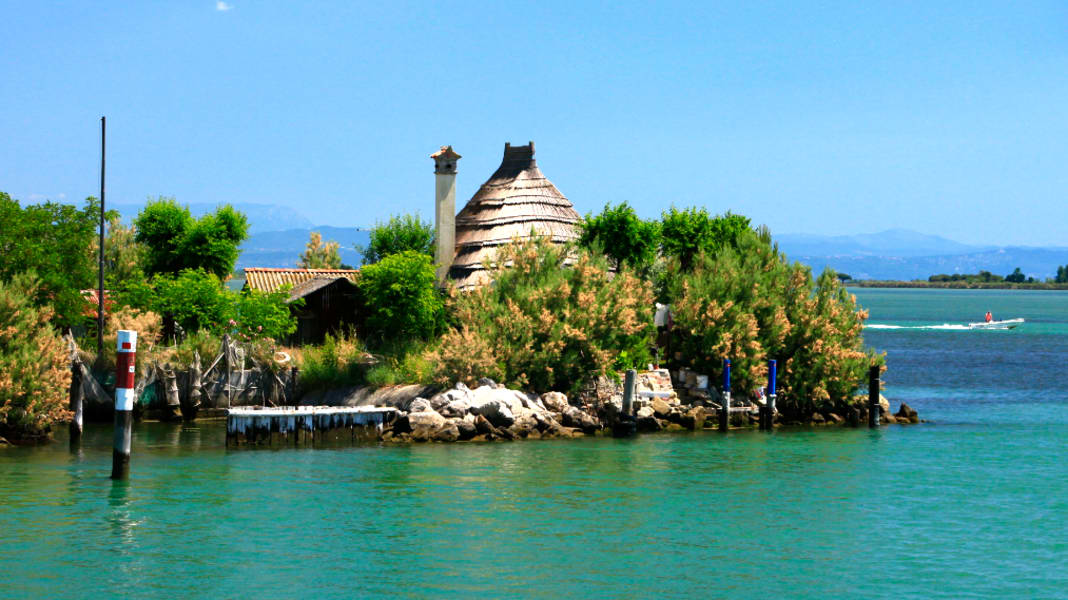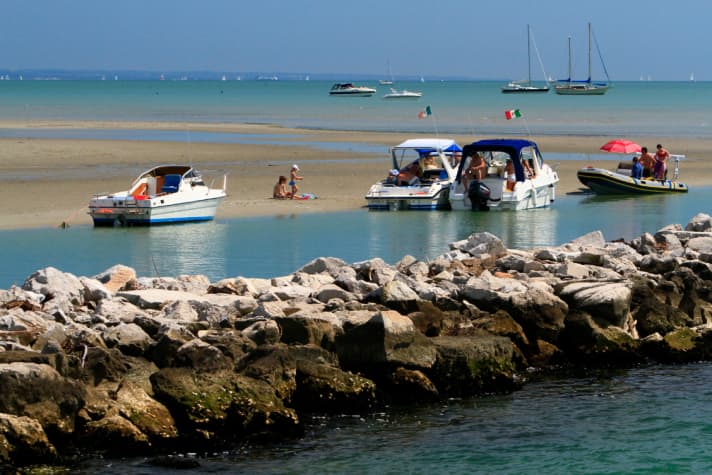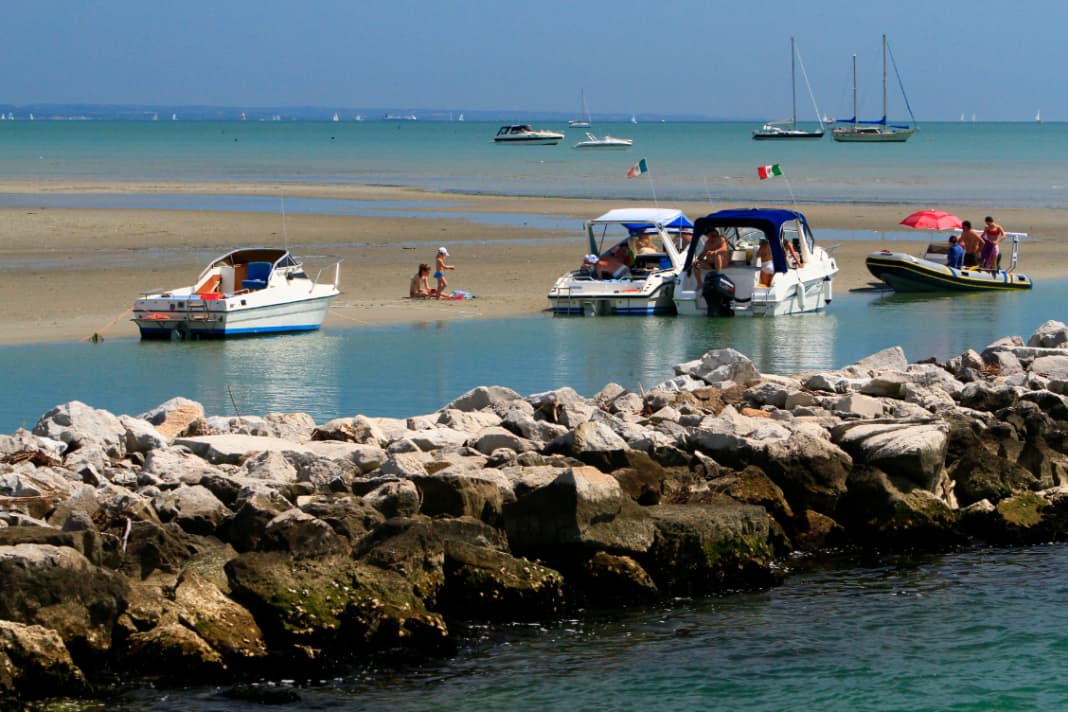







The lagoons of Marano and Grado, located between Venice and Trieste, are the newest destination for houseboat holidaymakers in Europe: a licence-free area with scenery worth seeing and beautiful old towns.
The Marano lagoon is the latest destination in the Houseboat hire company Le Boat and is still waiting to be discovered by charter crews. We took over a "Clipper" houseboat at the new charter base in Precenicco. The small town of Precenicco is located roughly halfway between Venice and Trieste. The supermarket in this pretty town on the Stella River has everything you need for a week-long cruise. With a full fridge, water and diesel tank, we head for the lagoon.

After the eight-kilometre-long river trip on the Stella, which flows leisurely southwards, the view opens up. Before us lies a unique landscape, the likes of which I have never seen before: a mirror-smooth lagoon on whose southern edge small islands seem to float. In between, endless rows of dolphins mark the fairways.
The Marano lagoon forms the southern end of the Friuli region in north-east Italy. In the far south, it is separated from the Adriatic Sea by a series of flat sandy islands. To the west is the lagoon of Venice, while Friuli borders Slovenia to the east.

If you want to sail on the lagoon, you don't need a compass or GPS. We received an overview map from the charter company on which all navigable fairways are marked. In reality, they are flanked by rows of red or green dolphins. There are signposts at all intersections, as we know them from road traffic. Shortcuts are not possible because you will inevitably end up in the mud.
We head south along the Canale Cialisia. Our destination for the day is the town of Lig-nano on the Adriatic. We intuitively learn the simple rules of the road, for example that even here you sail on the right and meet on the port side. We are the only houseboat and share the area with fishermen, motor yachts, excursion boats and a few sailors.

After just under two hours, we have crossed the lagoon to the south and are heading for the Porto Lignano marina. Even from a distance, the town of Lignano presents itself as a tourist resort with large hotels and a number of construction cranes under which new hotel blocks are growing.
In the afternoon, the north-westerly wind picks up just as we are heading into the marina. The marinero assigns us a guest berth between smart 20-metre motor yachts. I try to head for the spot, but the relatively weakly motorised houseboat with its large surface area becomes a plaything of the wind. The marinero sees our problem and sends a heavily motorised inflatable boat to gently manoeuvre us into the box.
The Adriatica Marina Lignano is a modern marina with exclusive sanitary facilities and all services. That comes at a price. We pay 60 euros for one night. The town of Lignano turns out to be a lively tourist resort. Hundreds of hotels are lined up along the Adriatic, with thousands of sunbeds and parasols on the beach in front.
You have to like spending your holiday in a place like this. We have a sundowner in the iconic "Teraza Mare" bar on the pier and decide to head east over the next few days, where the lagoon landscape is said to still be unspoilt.
The next day, we head westwards via the San Andrea, San Pietro and Muro canals. Our destination is Porto Buso on the Anfora headland, situated on a sandbank between the lagoon and the Adriatic Sea. Here, a shipping lane leads from the lagoon out into the open Adriatic.
Next to the eastern breakwater, which protects the passage to the open sea from silting up, are sandy beaches. A number of small motorboats are anchored in the shallow water between the pier and the beaches. People are swimming, drinking and partying. The concrete pier in front of the "Al Ciodi" excursion restaurant is occupied by excursion boats and water taxis. In the evening, the day trippers disappear and make room for us.
The restaurant, which is still packed in the afternoon, is deserted in the evening. Local chef Mauro sits down at our table and tells us that his family is the third generation to run the fish restaurant. "My fish comes fresh from the lagoon onto the grill," says Mauro proudly. "In the evening, when the excursion boats have gone," enthuses restaurateur Mauro, "this place is a paradise."
Mauro serves us octopus salad and grilled gilthead bream, accompanied by a salad of tomatoes and grated carrots. The food is simply prepared, but tastes excellent. And the ambience is unique, especially when the setting sun casts a golden glow over the island and the red house wine tastes even better.
On the way further east, we travel through the Grado lagoon. The canal meanders between small, flat islands. The typical fishermen's houses of the lagoon stand on them. The older ones are still thatched. Next to each house there is a small jetty where nets and fish traps are hung up to dry. The small huts on the islands are reminiscent of a time when people still lived here in the solitude of the lagoon and made a living from fishing. Today, most of the fishermen's houses are no longer permanently inhabited, but are used as weekend homes by hobby fishermen.
Shortly before Grado, the Canale della Taiada turns off to the left. The signpost points to Aquileia. We don't want to miss out on this famous ancient city. We cycle north along the "side road" for about three kilometres, then leave the lagoon and head uphill along the Natissa river. Roman galleys rowed along this waterway 2000 years ago and merchant ships sailed to Aquileia.
With a population of 100,000, it was one of the largest cities in the Roman Empire. The emperors Julius Caesar, Augustus and Marcus Aurelius resided here at times, as Aquileia was a military stronghold against the "barbarians". The trade routes to the north were also secured from here. The most important of these was the Amber Road from the Baltic Sea, which ended in Aquileia.
We steer our houseboat past the Aquileia marina and straight into the old town centre. The river narrows more and more, with local sailing boats moored alongside on the port side and local fishing boats and barges moored on the starboard side between red-marked dolphins. There are obviously no guest moorings. Why would there be? The locals have their place and there have been no charter boats so far.
Before the waterway becomes so narrow that we can no longer turn round, we see an open space on the north bank in front of a concrete platform and moor up. The feeling of having arrived in an ancient city doesn't really materialise. There is no sign of any of the remaining 3500 inhabitants. 300 metres east of our berth, the waterway ends in front of a bridge.
There is a central square with a supermarket and a few pubs. But everything seems deserted. Blinds and shutters are closed. We walk half a kilometre further east. Suddenly a completely different picture. Tour groups push their way through historic streets, past boutiques and taverns to the Roman Forum with its ancient portico, the former centre of Aquileia.
The centrepiece of this historic ensemble is the Basilica di Santa Maria, which is a
a UNESCO World Heritage Site. According to tradition, the evangelist St Mark is said to have proclaimed the new faith in Aquileia on behalf of the apostle Simon Peter. The basilica is one of the most
early Christian monuments in Italy, famous above all for its floor mosaics from the early 4th century.
From Aquileia, we travel three hours southwards to the lagoon town of Grado. Grado, which today has a population of 8,600, was founded in the 2nd century BC as a seaport of Aquileia and developed into an important military harbour. The old harbour is right in the centre, where we moor our houseboat.
Today, Grado lives mainly from tourism. It is the only town on the Adriatic where all the beaches face south. Nevertheless, we find Grado much more pleasant than Lignano. The town lives from the historical flair of its old walls with small shops, boutiques and quaint pubs.
According to the charter company, the lagoon landscape to the east of Grado is a protected area and therefore well worth seeing. We cross the causeway of Grado, the only road connection to the lagoon town, eastwards with the bridge train at 8 o'clock in the morning. After an hour we have the island of Santa Maria di Barbana to starboard. A pilgrimage church with the famous statue of the Madonna of Barbana has stood here since the 6th century. We moor in the monastery harbour and a friendly monk takes our lines and puts them around the bollards. As the pilgrim boats arrive in the course of the morning, we motor on.
At its eastern end, the Canal di Barbana forks into the Tanori and Primero canals, which rejoin after about two kilometres. The nature reserve is said to lie between them. To be honest, we don't get to see any more than in the rest of the lagoon landscape. Somewhat disillusioned, we head back to Grado and want to cross the swing bridge again.
After an hour, we find the bridge attendant. He explains loudly in Italian that an individual bridge opening is requested one day in advance by filling in a form at the Grado post office and is authorised after payment of 53.28 euros. Too bad. We have no choice but to wait for the regular bridge train the next morning at 8am. Fortunately, it's only a few minutes' walk to the beautiful and lively old town centre of Grado.
Our last leg of the trip takes us to the fishing village of Marano, which lies at the northern end of the lagoon of the same name. We leave the new marina on the right and moor in the old town harbour directly in front of Via Roma. It couldn't be more central. It is only a few steps to the piazza, which is called Granda here. There are ice cream parlours, bars and restaurants around the central square with its magnificent Venetian buildings and 1000-year-old fortified tower.
The visitor centre of the "Oasi Faunis-tica di Marano Lagunare" is around 300 metres from the harbour. Here, guests can find out everything they need to know about the wildlife in the lagoon and how the inhabitants used to live. Marano is a wonderful end to our week-long tour of the lagoon. While the low sun is already casting its golden glow over the reed forests, we steer our little boat back to the charter base in Precenicco.
WHAT SKIPPERS NEED TO KNOW
Company The charter company Le Boat, which belongs to the TUI Group, is the leading houseboat hire company in Europe with over 50 years of experience on the international market. Le Boat offers houseboat holidays in Germany, France, Italy, England, Ireland, Scotland, Belgium and Holland. The fleet includes around 1000 houseboats ranging in size from 8.80 to 14.97 metres in length. In Italy, Le Boat has been operating the charter bases Porto Levante and Casale in the greater Venice area for many years. The third base in Precenicco for tours on the lagoons of Marano and Grado has been new since 2011. One-way trips between the three charter bases are also possible.
Boat The "Clipper" houseboat we have rented has two separate double cabins with their own bathroom (shower/WC). Two additional berths are possible in the saloon. The saloon is generously sized and the galley is well equipped. There is an inside and an outside steering position. Despite its size, the boat is relatively easy to drive. Only in strong crosswinds can mooring manoeuvres become difficult.
Charter boats may be driven on the lagoons of the Italian Adriatic coast without a licence. "Excursions" to the open sea are of course not permitted. Technical data: Length 11.00 m, width 3.90 m, draught 0.80 m, water tank 800 litres, fuel tank 350 litres. Engine: 29 kW diesel (40 hp).
Prices Depending on the season, the "Clipper" houseboat from Precenicco costs between 1665 and 3020 euros per week. One-way trips to another charter base on the Italian Adriatic cost an additional 100 euros. The price includes bed linen, towels and nautical charts for the relevant area. Operating costs per engine hour: 7.60 euros.
Journey While it is perfectly possible to travel by car from southern Germany or Austria, a flight is probably the better alternative for all other charter guests. Precenicco is located exactly halfway between Venice and Trieste airports. With a budget airline, tickets (there and back) cost around 200 euros.
The transfer from "Marco Polo" airport near Venice to the Precenicco charter base (83 km) takes a good hour and costs 120 euros. Charter guests from Hamburg or Berlin can alternatively take the DB car train to Trieste. Depending on the season, day of travel, number of passengers and accommodation category, a journey costs between 100 and 650 euros.
Information and booking Le Boat , c/o Crown Blue Line GmbH, Theodor-Heuss-Str.
53-63, 61118 Bad Vilbel, phone: 0049 (0) 6101 557 91 12, e-mail: info@leboat.de, www.leboat.de
Cruising guide and charts The official nautical charts of the northern Adriatic are not suitable for navigation on the lagoons of Marano or Grado, as they do not show the waterways within the lagoons. At the charter base, guests receive the Italian land and water chart "Idrovia Litoranea Veneta e Aree Cos-tierre della Regione Friuli Venezia Giulia" from the Italian publisher Tabacco. This map at a scale of 1:75,000 clearly shows all navigable waterways within the lagoons of Marano and Grado and is absolutely sufficient for navigation by houseboat. We also recommend the nautical travel guide "Lagoon Secrets - Volume 1: From Grado to Cortellazzo" by Günter Lengnink, which comes with a set of maps and costs 25.00 euros. Available from www.virtualstore.de
Tips for the trip A houseboat trip on the lagoons of Marano and Grado does not require much prior knowledge of navigation and seamanship and is therefore also recommended for less experienced crews. Due to the short distances and the possibility of stopping for a swim on the Adriatic beaches (not in the lagoon), the trip is also recommended for families with children. Whilst we didn't like the seaside resort of Lignano with its hotel hotels as much, we found the historic towns of Grado, Aquileia and Marano very beautiful and interesting from a cultural and historical point of view. In one week, you have seen all the main places in the lagoons of Marano and Grado. If you want to charter for longer, you should extend the cruising area towards Venice.
Cruising stages

